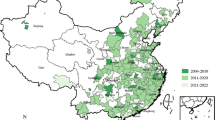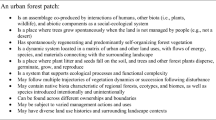Abstract
After 100 years, the USDA Forest Service has emerging opportunities to expand the Experimental Forest and Range (EFR) network to urban areas. The purpose of this expansion would be to broaden the types of ecosystems studied, interdisciplinary approaches used, and relevance to society of the EFR network through long-term and large-scale social–ecological projects in urban areas. The goals of these urban long-term research areas (ULTRAs) are to create scientifically rigorous knowledge of our urban regions and provide information needed to address current and future social–ecological problems.
The first of the four sections of this chapter explains the importance of understanding cities. Motivations for understanding cities are practical, scientific, and fundamental to the Forest Service’s mission. The extension of the EFR network can play a critical role in understanding the social and ecological dynamics of cities and serve the majority of Americans directly, where they live. In the second section, I identify key traits of ULTRA projects: What features they share with existing EFR sites and how they differ? A key feature of the EFR network is its focus on applied research. An example from the Baltimore Field Station illustrates how ULTRAs can catalyze and inform partnerships between research and decision making. In the third section, I detail the current status of the ULTRA effort. I conclude with a look at how the ULTRA program can continue its contribution to science and society.
Access this chapter
Tax calculation will be finalised at checkout
Purchases are for personal use only
Similar content being viewed by others
Notes
- 1.
Examples of recognition of the links between science findings and local benefits can be found from the BES, which was recognized through official proclamation for its service to the City of Baltimore by both Mayor Martin O’Malley (2004, 2006) and Mayor Sheila Dixon (2007, 2008).
References
Batty M (2011) Building a science of cities. Cities 29(S1):9–16
Brand S (2006) “City Planet.” strategy+business 42. http://www.strategy-business.com/press/16635507/06109. Accessed 10 April 2013
Brand S (2009) Whole earth discipline: an ecopragmatist manifesto. Viking Penguin, London, 316 p
Boone C, Cadenasso M, Grove JM (2009) Landscape, vegetation characteristics, and group identity in an urban and suburban watershed: why the 60s matter. Urban Ecosyst 13:255–271
Bormann FH, Likens GE (1979) Catastrophic disturbance and the steady state in northern hardwood forests. Am Sci 67(6):660–669
Carpenter SR (1998) The need for large-scale experiments to assess and predict the response of ecosystems to perturbation. In: Pace ML, Groffman PM (eds) Successes, limitations and frontiers in ecosystem science. Springer-Verlag, New York, pp 287–312
Chan S (2007) Considering the urban planet 2050. New York Times City Blog. Posted Dec. 4, 2007, 6:11 p.m. http://cityroom.blogs.nytimes.com/2007/12/04/considering-the-urban-planet-of-2050/?scp=1-b&sq=&st=nyt. Accessed 10 April 2013
City of New York (2007) plaNYC for a greener, greater New York City. http://nytelecom.vo.llnwd.net/o15/agencies/planyc2030/pdf/full_report_2007.pdf. Accessed 10 April 2013
Collins S, Swinton SM, Anderson CW, Benson BJ, Brunt J, Gragson TL, Grimm N, Grove JM, Henshaw D, Knapp AK, Kofinas G, Magnuson JJ, McDowell W, Melack J, Moore JC, Ogden L, Porter L, Reichman J, Robertson GP, Smith MD, Vande Castle J, Whitmer AC (2007) Integrated science for society and the environment: a strategic research initiative. LTER Network Office, Albuquerque, 35 p
Collins S, Carpenter SR, Swinton SM, Orenstein DE, Childers DL, Gragson TL, Grimm NB, Grove JM, Harlan SL, Kaye JP, Knapp AK, Kofinas GP, Magnuson JJ, McDowell WH, Melack JM, Ogden LA, Robertson GP, Smith MD, Whitmer AC (2011) An integrated conceptual framework for long-term social-ecological research. Front Ecol Environ 9(6):351–357
Couzin J (2008) Living in the danger zone. Science 319:748–749
Deutsch L, Jansson A, Troell M, Ronnback P, Folke C, Kautsky N (2000) The “ecological footprint”: communicating human dependence on nature’s work. Ecol Econ 32:351–355
Folke C, Jansson A, Larsson J, Costanza R (1997) Ecosystem appropriation by cities. Ambio 26:167–172
Galvin MF, Grove JM, O’Neil-Dunne JPM (2006) A report on Baltimore City’s present and potential urban tree canopy. Maryland Department of Natural Resources, Forest Service, Annapolis, 17 p
Garreau J (1991) Edge city: life on the new frontier. Doubleday, New York
Grimm N, Faeth S, Golubiewski N, Redman C, Wu J, Bai X, Briggs J (2008) Global change and the ecology of cities. Science 319:756–760
Groffman PM, Crawford MK (2003) Denitrification potential in urban riparian zones. J Environ Qual 32:1144–1149
Groffman PM, Boulware NJ, Zipperer WC, Pouyat RV, Band LE, Colosimo MF (2002) Soil nitrogen cycling processes in urban riparian zones. Environ Sci Technol 36:4547–4552
Groffman PM, Bain DJ, Band LE, Belt KT, Brush GS, Grove JM, Pouyat RV, Yesilonis IC, Zipperer WC (2003) Down by the riverside: urban riparian ecology. Front Ecol Environ 1:315–321
Grove JM (2009) Cities: managing densely settled social-ecological systems. In: Chapin FSI, Kofinas G, Folke C (eds) Principles of ecosystem stewardship: resilience-based natural resource management in a changing world. Springer-Verlag, New York
Grove JM, Troy AR, O’Neil-Dunne JPM, Burch WR, Cadenasso ML, Pickett STA (2006) Characterization of households and its implications for the vegetation of urban ecosystems. Ecosystems 9:578–597
Grove JM, Pickett STA, Whitmer A, Cadenasso M (2013) Building an urban LTSER: the case of the Baltimore Ecosystem Study and the D.C./B.C. ULTRA-Ex Project. In: Singh SJ, Chertow M, Mirtl M, Schmid M (eds) Long term socio-ecological research: studies in society-nature across spatial and temporal scales. Springer-Verlag
Hough M (1984) City form and natural process: towards a new urban vernacular. Van Nostrand Reinhold, New York
Johnson S (2006) The ghost map: the story of London’s most terrifying epidemic-and how it changed science, cities, and the modern world. Riverhead Books, New York
Katz B, Bradley J (1999) Divided we sprawl. Atl Month 284(6):26–42
Makse HA, Havlin S, Stanley HE (1995) Modeling urban growth patterns. Nature 377:608–612
Melosi MV (2000) The sanitary city: urban infrastructure in America from colonial times to the present. Johns Hopkins University, Baltimore
National Oceanic and Atmospheric Administration (2004) Population trends along the coastal United States: 1980–2008. Coastal Trends report series, US Department of Commerce, Washington, DC
O’Neil-Dunne JPM, Grove JM (2011) A report on the City of Philadelphia’s existing and possible tree canopy. US Department of Agriculture, Forest Service, Northern Research Station, South Burlington, VT. http://www.fs.fed.us/nrs/utc/reports/UTC_Report_Philadelphia.pdf. Accessed 10 April 2013
Pickett STA, Cadenasso M (2007) Linking ecological and built components of urban mosaics: an open cycle of ecological design. Ecology 96(1):1–5
Pickett STA, Cadenasso ML (2009) Altered resources, disturbance, and heterogeneity: a framework for comparing urban and non-urban soils. Urban Ecosyst 12:23–44
Pickett STA, Cadenasso ML, Grove JM, Nilon CH, Pouyat RV, Zipperer WC, Costanza R (2001) Urban ecological systems: linking terrestrial ecological, physical, and socioeconomic components of metropolitan areas. Annu Rev Ecol Syst 32:127–157
Pickett STA, Cadenasso ML, Grove JM (2004) Resilient cities: meaning, models and metaphor for integrating the ecological, socio-economic, and planning realms. Landsc Urban Plan 69:369–384
Pickett STA, Belt KT, Galvin MF, Groffman P, Grove JM, Outen DC, Pouyat R, Stack WP, Cadenasso ML (2007) Watersheds in Baltimore, Maryland: understanding and application of integrated ecological and social processes. J Contemp Water Res Educ 136(June):44–55
Pickett STA, Boone CG, McGrath BP, Cadenasso ML, Childers DL, Ogden LA, McHale M, Grove JM (2013) Ecological science and transformation to the sustainable city. J Cities. http://dx.doi.org/10.1016/j.cities.2013.02.008. Accessed 10 April 2013
Raciti S, Galvin MF, Grove JM, O’Neil-Dunne J, Todd A (2006) Urban tree canopy goal setting: a guide for communities. US Department of Agriculture, Forest Service, Chesapeake Bay Program Office, Northeastern Area, State and Private Forestry, Annapolis, MD
Romolini M (2013) Governance of 21st century sustainable cities: examining stewardship networks in Baltimore & Seattle. Unpublished doctoral dissertation, University of Vermont, Burlington, VT
Romolini M, Grove JM (2010) Polycentric networks and resilience in urban systems: a comparison of Baltimore and Seattle. Available from Nature Precedings. http://dx.doi.org/10.1038/npre.2010.5222.1. Accessed 10 April 2013
Schaaf T, Zhao X, Keil G (1995) Towards a sustainable city: methods of urban ecological planning and its application in Tianjin, China. Urban System Consult GmbH, Berlin
Seto K, Sanchez-Rodriguez R, Fragkias M (2010) The new geography of contemporary urbanization and the environment. Ann Rev Environ Resour 35:167–194
Singh SJ, Chertow M, Mirtl M, Schmid M (eds) (2013) Long term socio-ecological research: studies in society-nature across spatial and temporal scales. Springer-Verlag, New York, 588 p
Spirn AW (1984) The granite garden: urban nature and human design. Basic Books, New York, 362 p
Svendsen ES, Campbell LK (2008) Urban ecological stewardship: understanding the structure, function and network of community-based urban land management. Cities Environ 1(1):1–32
Swanson FJ, Goodrich C, Moore KD (2008) Bridging boundaries: scientists, creative writers, and the long view of the forest. Front Ecol Environ 6(9):499–504
Thompson GE, Steiner FR (1997) Ecological design and planning. Wiley, New York, 348 p
Toepfer K (2005) From the desk of Klaus Toepfer, United Nations Under-Secretary-General and Executive Director, UNEP. Our Planet. 1
Troy AR, Grove JM, O’Neil-Dunne J, P M, Cadenasso M, Pickett STA (2007) Predicting patterns of vegetation and opportunities for greening on private urban lands. Environ Manag 40:394–412
Zhou W, Grove JM, Troy A, Jenkins JC (2009) Can money buy green? Demographic and socioeconomic predictors of lawncare expenditures and lawn greenness in urban residential areas. Soc Nat Resour 22:744–760
Author information
Authors and Affiliations
Corresponding author
Editor information
Editors and Affiliations
Rights and permissions
Copyright information
© 2014 Springer New York
About this chapter
Cite this chapter
Grove, J. (2014). Expanding the Vision of the Experimental Forest and Range Network to Urban Areas. In: Hayes, D., Stout, S., Crawford, R., Hoover, A. (eds) USDA Forest Service Experimental Forests and Ranges. Springer, New York, NY. https://doi.org/10.1007/978-1-4614-1818-4_27
Download citation
DOI: https://doi.org/10.1007/978-1-4614-1818-4_27
Published:
Publisher Name: Springer, New York, NY
Print ISBN: 978-1-4614-1817-7
Online ISBN: 978-1-4614-1818-4
eBook Packages: Biomedical and Life SciencesBiomedical and Life Sciences (R0)




